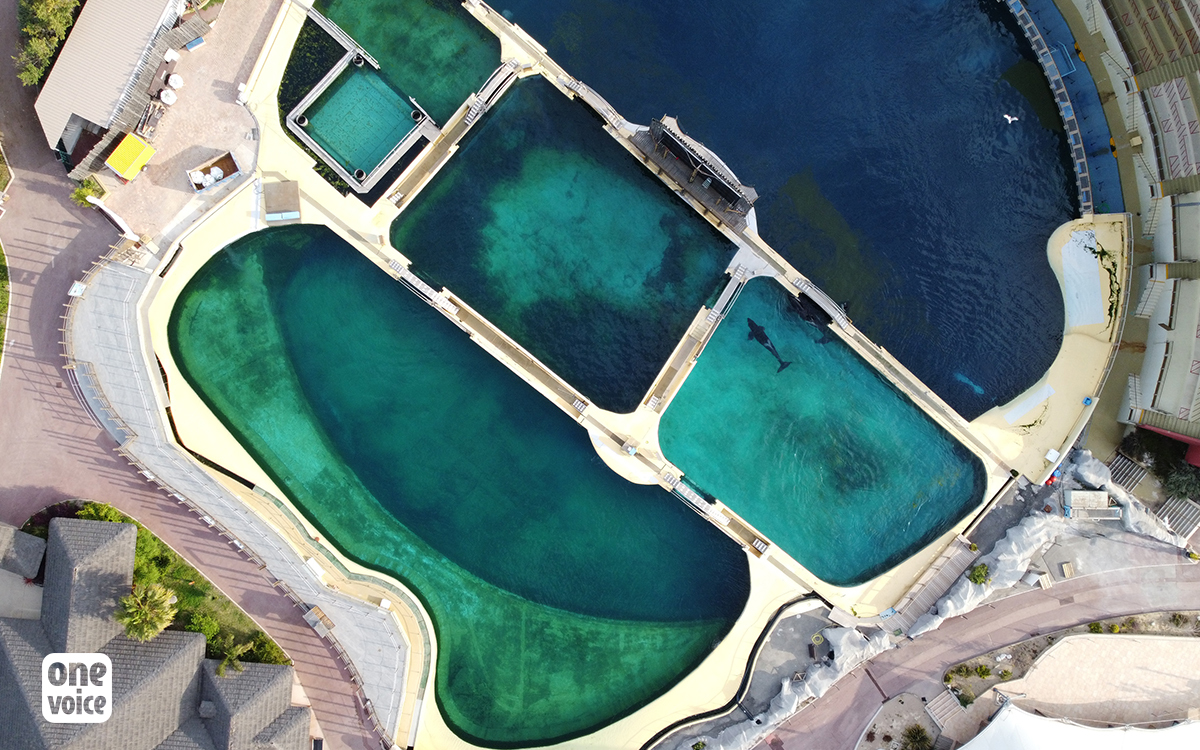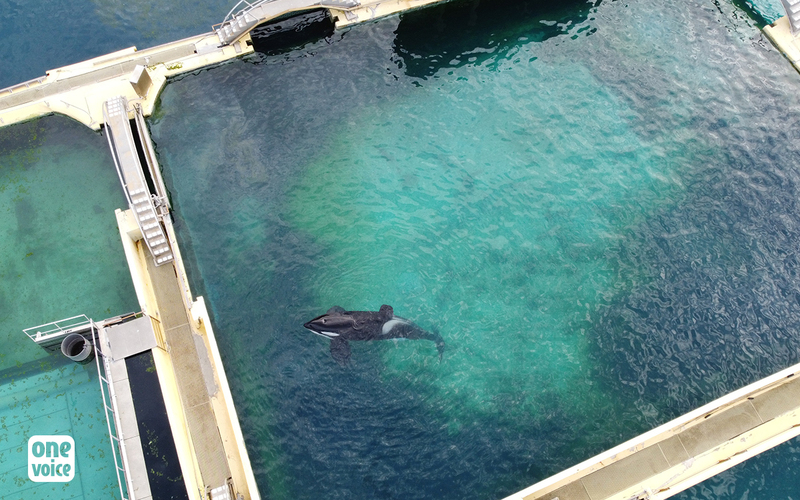
Unpublished images of Inouk, the orcas, and the dolphins at Marineland in Antibes
In footage of the closed Marineland in Antibes we received from a whistleblower, we saw Inouk sluggish against a wall, and pools tarnished with algae ...
Marineland in Antibes is expected to reopen on 11 June 2021. For months, Inouk, Keijo, Moana, and Wikie no longer endure repeated performances. However, the four orcas, kept in the dolphinarium along with the dolphins, are still isolated in concrete tanks with no depth or length and no fish or crustaceans. In the images of the park that One Voice received from a whistle-blower, Inouk can be seen subdued and facing a wall (like Femke during her time in Astérix Park) and the tanks are clouded with algae. The association for animal rights is currently working towards the solution of a safe haven; “our” four orcas must not be sent to China or die in these tanks!
For years, we have condemned the experiences of the orcas and dolphins exploited in dolphinariums. The scientific proof that cetaceans are highly intelligent animals and possess their own culture is currently being acquired; it is doubtful that their fate remains the same for those who are born in captivity. A few months ago, we found out about a plan to move the four orcas, from Marineland in Antibes to China, to parks which belong to the group who own the French dolphinarium. Our campaign prevented their departure and, a few months later, the Ministry of the Ecological Transition announced the end of captive cetacean exploitation. Whether it be Femke or her companions, the dolphins at Astérix Park, they paid the price. We cannot make do with the solution that the dolphinariums have proposed. Surrounded by leading specialists, we are working towards solutions that allow these four French orcas to benefit from a different life as soon as possible.
We have sent these unpublished images from Marineland to cetacean (specifically orca) specialists for their expertise.
For Dr. Ingrid Visser, a biologist who specialises in cetaceans (Orca Research Trust, New Zealand), who exposed Inouk’s health problems through ascientific publication and report, the algae, visible all over the bottom of the tanks, doesn’t show that the water has a good pH balance, but instead shows a problem with the filtration and the pump circulating the water. Their development can only happen if nutrients exist; here, they are evidently the cetacean’s faeces and the remains of dead fish which are given to them.
«There are of course concerns that dead fish, animal excrement etc can accumulate in the bottom of the tank(s) and not be extracted, creating a reservoir for diseases.»
For Dr Pierre Gallego, a marine wildlife veterinary specialist who shares this point of view, the slowed swimming behaviour of the dolphins and orcas are a sign of boredom, which can lead to “prostration and stereotyped movements”: signs of distress, caused by captivity and the absence of all enrichment (toys, waves, or other stimulation) in the tanks. This analysis echoes that which Dr Naomi Rose also states below regarding boredom, which can pose health problems, and that which Dr Ingrid Visser reported on in her previous analysis of Inouk in 2019.
On Inouk, Dr Gallego noted that:
«[He] can be observed immobile at the surface of the water, a behaviour which is not frequent in the wild, but much more frequent in captivity… The fact that the fin is completely collapsed clearly shows that Inouk doesn’t swim enough, and therefore that the size of the tanks is inadequate.»
For Dr Naomi Rose (PhD), a marine mammal scientific specialist (Animal Welfare Institute, USA), while waiting for marine sanctuaries that can welcome them to emerge (many are already built or are being expanded), the orcas must stay where they are and their wellbeing must be improved, notably by immediately stopping performances.
«Training the animals to entertain people goes against their wellbeing. They are made to do the same performances day after day…
In the wild, no one day will resemble another. The change, variety, and wide range of stimulation and even challenges, constitute a normal existence for a dolphin or an orca in their wild state, whilst in captivity, every day is identical…
This boredom is harmful and can result in depression, which itself can lead to health problems. In short, change doesn’t really exist in the kind of life that we offer them. The situation must evolve, offering them variety and choice. Therefore, at the very least, we must improve their wellbeing in their current environment and that will be the short-term solution for virtually all of them…
However, long-term, I think that the marine sanctuaries situated in different places around the world can help a lot. In my opinion, any sanctuary can shelter at least one, or maybe even two dozen animals.»
We have been working for months with the leading worldwide orca specialists for a solution for marine sanctuaries. We are open and ready to discuss, with the guidance of Marineland, so that Inouk, Keijo, Moana, and Wikie are finally able to live somewhere other than in a concrete tank.
Translated from the French by Joely Justice